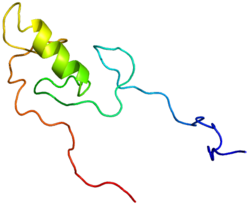TRIM5alpha
| TRIM5alpha | ||
|---|---|---|

|
||
| according to 2ECV | ||
| Properties of human protein | ||
| Mass / length primary structure | 493 amino acids | |
| Secondary to quaternary structure | Homotrimer (α) | |
| Isoforms | α, β, γ, δ, ε | |
| Identifier | ||
| Gene names | TRIM5 RNF88 | |
| External IDs | ||
| Enzyme classification | ||
| EC, category | 6.3.2. , Ligase | |
| Response type | Auto-ubiquitinylation | |
| Orthologue | ||
| human | House mouse | |
| Entrez | 85363 | 319236 |
| Ensemble | ENSG00000132256 | ENSMUSG00000057143 |
| UniProt | Q9C035 | |
| Refseq (mRNA) | NM_033034 | NM_001146007 |
| Refseq (protein) | NP_149023 | NP_001139479 |
| Gene locus | Chr 11: 5.66 - 5.94 Mb | Chr 7: 104.34 - 104.35 Mb |
| PubMed search | 85363 |
319236
|
TRIM5α (also TRIM5alpha or TRIM5alpha ) is a protein that in the cells of most primates occurs and against various infections with retroviruses acts. It prevents monkeys from becoming infected with HIV-1 and prevents infection with some other retroviruses in humans. Together with the APOBEC3G protein family and the recently discovered protein tetherin , TRIM5α forms an important part of the innate immunity against retroviruses. The human TRIM5α consists of 493 amino acids and the gene locus is on chromosome 11 . TRIM5α belongs to the TRIM protein family, which was described by Reddy in 1992 as proteins that have a RING finger zinc binding domain and a B-box zinc binding domain followed by a coiled-coil region. “TRIM” therefore stands for “TRIpartite Motif”, i. H. tripartite motif.
Monkey relatives cannot be infected with HIV-1, but they can with SIV , a closely related virus. In 2004 Stremlau and others isolated TRIM5α from rhesus monkeys and identified the protein as responsible for the “block” against HIV-1. The human TRIM5α is not directed against HIV-1, but inhibits the retroviruses MLV and EIAV .
When a retrovirus enters the cytoplasm of a cell, the capsid disintegrates (uncoating), the RNA is released and reverse transcription can take place. TRIM5α, which is present in the cytoplasm, recognizes a protein motif within the capsid protein of the virus and interferes with the uncoating process so that the subsequent reverse transcription cannot take place and the virus genome cannot be introduced into the cell nucleus. The mechanism is not yet known in detail. It is believed that other cellular proteins are involved in the process.
Individual evidence
- ↑ F. Kirchhoff: "Optimal" adaptation of pandemic HIV-1 strains to humans . In: BIOspectrum . tape 2 , 2010, p. 144-148 .
- ↑ A. Tokarev et al: Antiviral activity of the interferon-induced cellular protein BST-2 / tetherin . In: AIDS Res Hum Retroviruses . tape 25 , no. December 12 , 2009, pp. 1197-1210 , PMID 19929170 .
- ^ BA Reddy, LD Etkin, PS Freemont: A novel zinc finger coiled-coil domain in a family of nuclear proteins . In: Trends Biochem Sci . 17, 1992, pp. 344-345. PMID 1412709 .
literature
- S. Nisole, JP Stoye, A. Saib: TRIM family proteins: retroviral restriction and antiviral defense. In: Nat Rev Microbiol . 3 (10), 2005 Oct, pp. 799-808. Review. PMID 16175175
- M. Emerman: How TRIM5alpha defends against retroviral invasions. In: Proc Natl Acad Sci USA . 103 (14), 2006 Apr 4, pp. 5249-5250. PMID 16567650
Web links
- Swiss Prot
- Protein sequence from the Entrez Gene protein database